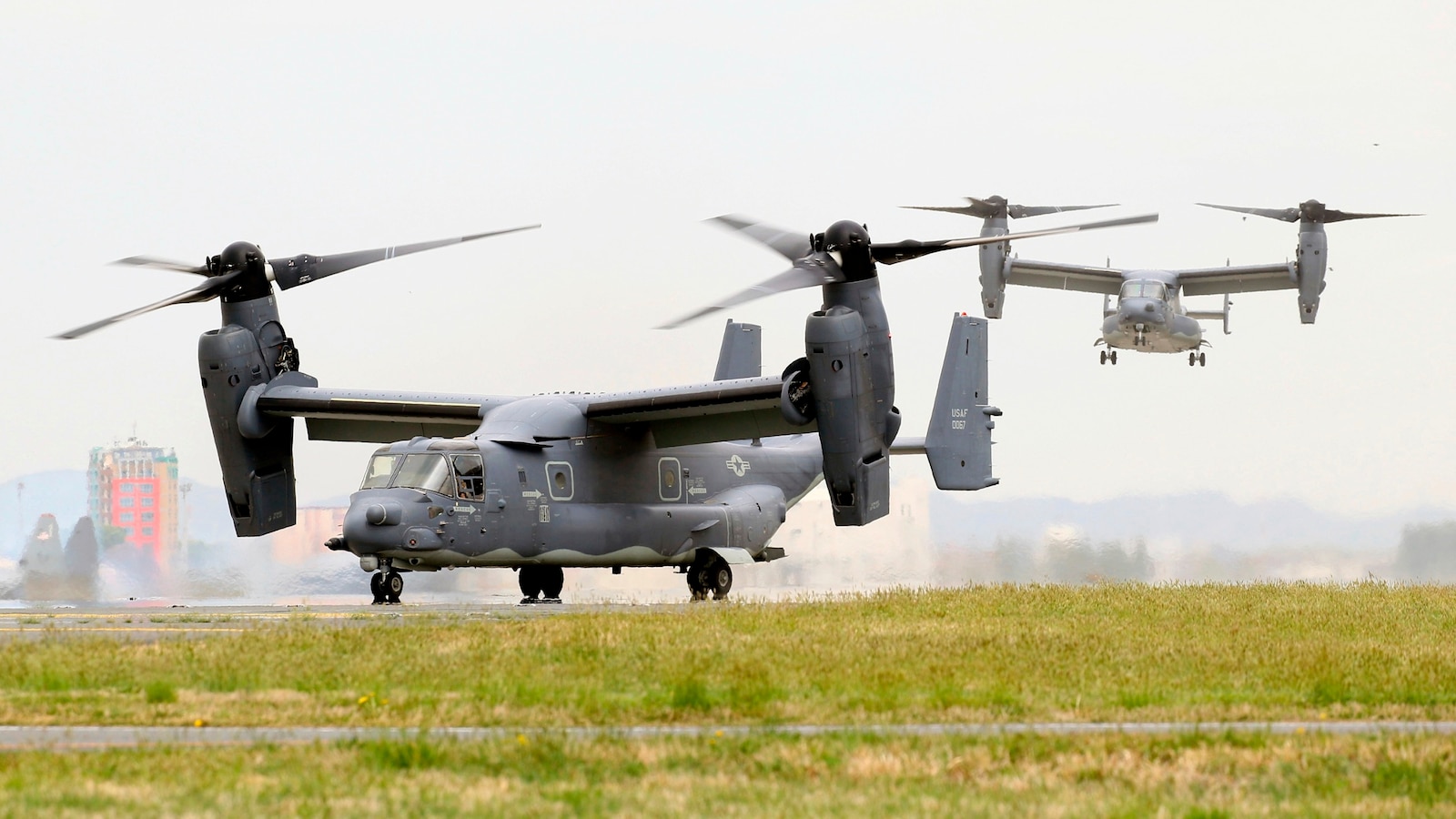
The US military has lifted its flight ban on V-22 Osprey aircraft after a deadly crash in Japan killed eight service members last fall, paving the way for the tilt rotorcraft to fly again for the first time in three months.
The decision comes even as the investigation into that crash and a separate deadly accident in Australia are still under way.
“I have high confidence that the protocols we’re putting in place will avoid a catastrophic event like this happening again in the future,” said Lt. Gen. Tony Bauernfeind, commander of Air Force Special Operations Command, whose members died in the crash.
Bauernfeind and other senior military officials told reporters this week that the November crash in Japan was caused by a “materiel failure” that they believe can be addressed with additional training and maintenance requirements.
No hardware changes are being made to the platform.
But officials acknowledged that they still don’t know why the failure happened, in part because the wreckage was submerged under water for a month following the crash, causing severe corrosion.
Officials declined to provide precise details on which components failed and how it would be fixed, citing security concerns.
“We have high confidence that we understand what component failed and how it failed,” said Marine Col. Brian Taylor, program manager for the V-22 joint program at US Naval Air Command, which made the decision to ground the Ospreys across all services.
“I think what we are still working on is the why, and so that is still in the hands of the investigation,” Taylor said.
The decision is unlikely to be the final word in the case of the V-22, which is linked to 20 service member deaths in the past two years.
A top House Republican said his panel still hasn’t been given the information it’s requested and that its independent investigation into the November crash and other mishaps will continue.
“We will continue to rigorously investigate the DoD’s Osprey program to attain answers to our questions on behalf of American taxpayers and protect U.S. service members defending our nation,” said Rep. James Comer, chairman of the House Oversight Committee.
In addition to the Nov. 29 crash in Japan last year, a V-22 went down in August 2023 during a training exercise off the northern coast of Australia, killing three Marines. That investigation continues.
Officials told reporters this week that the Australia crash involving the V-22 was considered a separate matter, although they did not provide further details.
There were two other deadly mishaps in 2022 – one later attributed to pilot error in severe weather, the other to a clutch problem.
The Pentagon has been eager to return the V-22 to flight because of its unique ability to conduct missions in far-flung parts of the globe, including the Pacific.
The Osprey can take off and land like a helicopter and depart from Navy ships and land on islands without runways. Because its propellers can tilt forward, the aircraft can fly faster than helicopters, making it easier to ferry troops and equipment to remote bases.
Investigators had long suspected that the November 2023 crash in Japan was caused by a materiel failure with the aircraft, not human error or bad weather. The Dec. 6 order issued by US Naval Air Command grounded all versions of the Osprey flown by the Marine Corps, Air Force and Navy.
It’s unlikely V-22s will return to the air right away, with the services noting they will need to enact additional training and maintenance requirements.
Brig. Gen. Richard D. Joyce, the Marine Corps’ assistant deputy commandant for aviation, said his crews are already flying on simulators to get used to the new protocols.
When asked how families of service members should feel about the V-22 flying again with the final investigation still under way, officials said they were as confident as they could be it won’t happen again.
NAVAIR’s Taylor compared the situation to someone who is wet and needs to towel off. You might not know why exactly that person is wet – maybe they got stuck in the rain, or they went swimming — but you can be confident the problem is fixed by handing them a towel.
Added Bauernfeind: “There are good estimations and good analytical reasoning of why we think it failed, and there will be follow-on testing to get that 100% confirmation.”
The US military has recently announced that it will allow the V-22 Osprey aircraft to resume flights after a suspension that was put in place following a fatal crash. The decision comes after a thorough investigation into the cause of the crash and the implementation of new safety measures to prevent similar incidents in the future.
The V-22 Osprey is a unique aircraft that combines the vertical takeoff and landing capabilities of a helicopter with the speed and range of a fixed-wing aircraft. It has been used by the US military for a variety of missions, including troop transport, search and rescue, and special operations.
In April of this year, a V-22 Osprey crashed during a training exercise in Hawaii, resulting in the deaths of three Marines. Following the crash, the military grounded all V-22 Osprey aircraft to conduct a thorough investigation into the cause of the accident.
The investigation found that the crash was caused by a combination of mechanical failure and human error. In response, the military has implemented new safety measures, including additional training for pilots and maintenance crews, as well as improvements to the aircraft’s systems to prevent similar incidents from occurring in the future.
Despite the tragic crash, the military has determined that the V-22 Osprey is still a valuable asset and will allow it to resume flights. The decision to lift the suspension comes after careful consideration of the safety measures that have been put in place to mitigate the risks associated with operating the aircraft.
The V-22 Osprey has been a controversial aircraft since its inception, with critics citing concerns about its safety and reliability. However, supporters argue that it provides unique capabilities that are essential for modern military operations.
With the resumption of flights, the V-22 Osprey will once again be able to support a wide range of missions for the US military. While the decision to allow the aircraft to fly again may be met with some skepticism, the military is confident that the new safety measures will help prevent future accidents and ensure the safety of those who operate and rely on the V-22 Osprey.


